Tesco: Management and Enterprise in Engineering Case Study Report
VerifiedAdded on 2021/04/24
|23
|6536
|8
Report
AI Summary
This report provides an in-depth analysis of Tesco, a leading global retailer. It examines Tesco's historical background, including its establishment and expansion strategies. The report delves into Tesco's management structure, highlighting the board of directors, executive committee, and organizational hierarchy, particularly at the store level. It explores Tesco's business model, focusing on its evolution from traditional supermarkets to online shopping and the adoption of the 'click and collect' system. The report also analyzes Tesco's dynamical model, including its acquisitions and purchasing strategies, self-production of goods, and online shopping system. Furthermore, it discusses Tesco's digital in-store implementations, such as self-checkout and scan-as-you-shop devices, and the development of the Tesco Clubcard loyalty program. The report concludes with a discussion of Tesco's diversification strategies and future innovations.

Management and Enterprise in Engineering
1
1
Paraphrase This Document
Need a fresh take? Get an instant paraphrase of this document with our AI Paraphraser
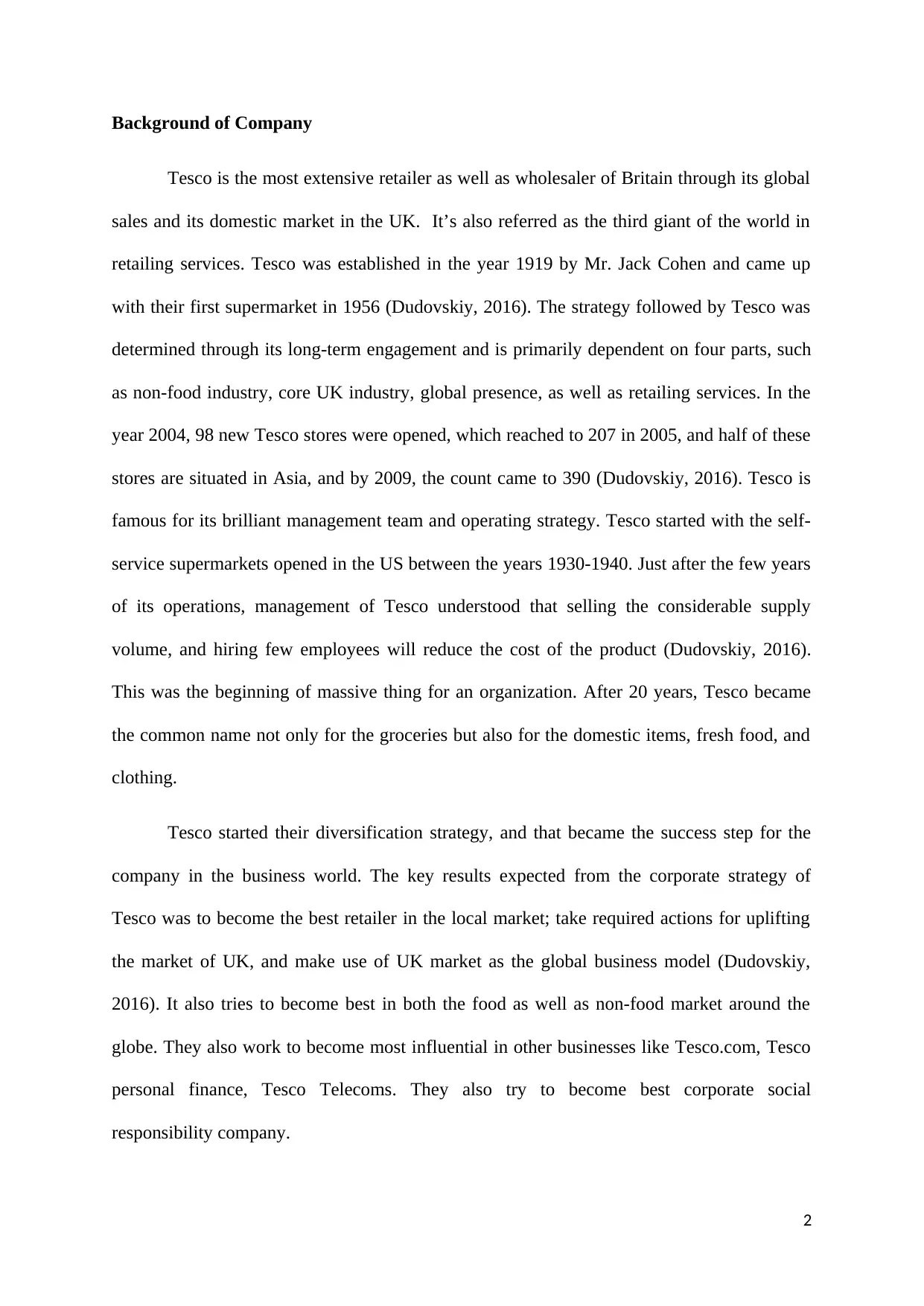
Background of Company
Tesco is the most extensive retailer as well as wholesaler of Britain through its global
sales and its domestic market in the UK. It’s also referred as the third giant of the world in
retailing services. Tesco was established in the year 1919 by Mr. Jack Cohen and came up
with their first supermarket in 1956 (Dudovskiy, 2016). The strategy followed by Tesco was
determined through its long-term engagement and is primarily dependent on four parts, such
as non-food industry, core UK industry, global presence, as well as retailing services. In the
year 2004, 98 new Tesco stores were opened, which reached to 207 in 2005, and half of these
stores are situated in Asia, and by 2009, the count came to 390 (Dudovskiy, 2016). Tesco is
famous for its brilliant management team and operating strategy. Tesco started with the self-
service supermarkets opened in the US between the years 1930-1940. Just after the few years
of its operations, management of Tesco understood that selling the considerable supply
volume, and hiring few employees will reduce the cost of the product (Dudovskiy, 2016).
This was the beginning of massive thing for an organization. After 20 years, Tesco became
the common name not only for the groceries but also for the domestic items, fresh food, and
clothing.
Tesco started their diversification strategy, and that became the success step for the
company in the business world. The key results expected from the corporate strategy of
Tesco was to become the best retailer in the local market; take required actions for uplifting
the market of UK, and make use of UK market as the global business model (Dudovskiy,
2016). It also tries to become best in both the food as well as non-food market around the
globe. They also work to become most influential in other businesses like Tesco.com, Tesco
personal finance, Tesco Telecoms. They also try to become best corporate social
responsibility company.
2
Tesco is the most extensive retailer as well as wholesaler of Britain through its global
sales and its domestic market in the UK. It’s also referred as the third giant of the world in
retailing services. Tesco was established in the year 1919 by Mr. Jack Cohen and came up
with their first supermarket in 1956 (Dudovskiy, 2016). The strategy followed by Tesco was
determined through its long-term engagement and is primarily dependent on four parts, such
as non-food industry, core UK industry, global presence, as well as retailing services. In the
year 2004, 98 new Tesco stores were opened, which reached to 207 in 2005, and half of these
stores are situated in Asia, and by 2009, the count came to 390 (Dudovskiy, 2016). Tesco is
famous for its brilliant management team and operating strategy. Tesco started with the self-
service supermarkets opened in the US between the years 1930-1940. Just after the few years
of its operations, management of Tesco understood that selling the considerable supply
volume, and hiring few employees will reduce the cost of the product (Dudovskiy, 2016).
This was the beginning of massive thing for an organization. After 20 years, Tesco became
the common name not only for the groceries but also for the domestic items, fresh food, and
clothing.
Tesco started their diversification strategy, and that became the success step for the
company in the business world. The key results expected from the corporate strategy of
Tesco was to become the best retailer in the local market; take required actions for uplifting
the market of UK, and make use of UK market as the global business model (Dudovskiy,
2016). It also tries to become best in both the food as well as non-food market around the
globe. They also work to become most influential in other businesses like Tesco.com, Tesco
personal finance, Tesco Telecoms. They also try to become best corporate social
responsibility company.
2

Company structure
Board of directors at Tesco includes ten members, and many significant changes were
made during 2014/15 financial year. All these changes cover up John Allan appointment as
the Chairman of the board, new CEO Dave Lewis, and new CFO Alan Steward appointment,
along with the four non-executive director’s retirement and joining of 3 non-executive
directors (Dudovskiy, 2016). In the year 2015, CEO of Tesco announced the price reduction
all around the functions of head office by 30% and the same was directly implemented on the
Tesco management structure. As given below, the governance structure of the company
includes five committees reporting to the board of Tesco. Along with this, there are 11
members involved in an Executive committee of Tesco that is led by the Group chief
executive (Dudovskiy, 2016).
Corporate Governance Structure of Tesco
The organizational structure at Tesco is hierarchical, which depicts the business size.
At the store level, there are four layers of management at particular large stores. Below figure
shows the organizational structure followed at Extra formats, Metro and Superstore
(Winterman, 2016). It is crucial to note that below structure is not rigid for all the stores
owned by Tesco, including slight variant structure, which also shows the size, location as
well as a range of the various other factors of stores (Winterman, 2016).
3
Board of directors at Tesco includes ten members, and many significant changes were
made during 2014/15 financial year. All these changes cover up John Allan appointment as
the Chairman of the board, new CEO Dave Lewis, and new CFO Alan Steward appointment,
along with the four non-executive director’s retirement and joining of 3 non-executive
directors (Dudovskiy, 2016). In the year 2015, CEO of Tesco announced the price reduction
all around the functions of head office by 30% and the same was directly implemented on the
Tesco management structure. As given below, the governance structure of the company
includes five committees reporting to the board of Tesco. Along with this, there are 11
members involved in an Executive committee of Tesco that is led by the Group chief
executive (Dudovskiy, 2016).
Corporate Governance Structure of Tesco
The organizational structure at Tesco is hierarchical, which depicts the business size.
At the store level, there are four layers of management at particular large stores. Below figure
shows the organizational structure followed at Extra formats, Metro and Superstore
(Winterman, 2016). It is crucial to note that below structure is not rigid for all the stores
owned by Tesco, including slight variant structure, which also shows the size, location as
well as a range of the various other factors of stores (Winterman, 2016).
3
⊘ This is a preview!⊘
Do you want full access?
Subscribe today to unlock all pages.

Trusted by 1+ million students worldwide

It can be mentioned that four management layers at Tesco existing in the individual
store might develop unrequired bureaucracy with the wrong implication over the information
flow all across the Tesco management layers (Winterman, 2016). That’s why it is required
that senior management needs to refer the delayering options such as rising of operational
flexibility in store and acceleration of information flow through the reduction of management
layers (Winterman, 2016).
Business Model
Tesco is one of the biggest grocery and commercial store around the world, and it also
acts as the leading market force in the context of the European market. Tesco is not only
successful regarding selling the items, but at the same time, it is professional and unique in
the way it handles the business as well as future possibilities of growth (Reading, 2004).
Tesco business model is discussed in this section, about how the brand expands dynamically
and has tried to conquer the market of Europe. In the starting of 2000, the UK was considered
as the prime for the internet shopping of grocery items as well as home delivery because of
the adoption rates of high technology and high population areas density (Reading, 2004). In
the year 2000, Tesco has quickly responded towards the opportunities available and has also
4
store might develop unrequired bureaucracy with the wrong implication over the information
flow all across the Tesco management layers (Winterman, 2016). That’s why it is required
that senior management needs to refer the delayering options such as rising of operational
flexibility in store and acceleration of information flow through the reduction of management
layers (Winterman, 2016).
Business Model
Tesco is one of the biggest grocery and commercial store around the world, and it also
acts as the leading market force in the context of the European market. Tesco is not only
successful regarding selling the items, but at the same time, it is professional and unique in
the way it handles the business as well as future possibilities of growth (Reading, 2004).
Tesco business model is discussed in this section, about how the brand expands dynamically
and has tried to conquer the market of Europe. In the starting of 2000, the UK was considered
as the prime for the internet shopping of grocery items as well as home delivery because of
the adoption rates of high technology and high population areas density (Reading, 2004). In
the year 2000, Tesco has quickly responded towards the opportunities available and has also
4
Paraphrase This Document
Need a fresh take? Get an instant paraphrase of this document with our AI Paraphraser

adapted the business model through setting up the internet grocery channel, such as Tesco
Direct (Reading, 2004).
By the year 2006, internet sales of the company were grown rapidly to around 23%,
and for fulfilling the demands, the company augmented the operating model through
investing in the centres of grocery dotcom; warehouses were open mainly for the fulfilment
of online orders that were equipped with the innovative goods picking technology (Reading,
2004). In the year 2011, for providing the future convenience to the customers and for
enhancing the profitability of the business model by reducing the cost of home delivery,
Tesco had lead the competitive pack through providing the Omni channel function of “click
and collect’, through which customers can place the orders online and gather the groceries at
the gathering point of their own choice (Reading, 2004). Despite the upside of revenue, the
shift happened in the Omni channel of bricks and clicks, offer came through the issues related
to operating model of Tesco; substantial investment was made informing the online platform,
investment was also made in the centres of grocery dotcom to around £1.5-3.5million per
warehouse, investment was also made in the home delivery of labour and ordering difficulties
in supply chain due to the wrong forecasting of the internet grocery orders due to lack of
historical information (Ruther, 2003).
Dynamical model
Tesco is far away from the dynamics, in case of looking at the rapid expansion in the
complete UK. Later on, they had also conquered complete Eastern Europe, Scotland, and
Ireland. The speedy development is done by timing and luck of the company. Tesco has
attained huge stores through purchasing it from weak competitors (Levy, 2012). In UK
market, Tesco brand has been famous for obtaining small to mid-size stores, which result in
achieving many new stores with the single transaction in business (McDonald, 2009).
Purchasing equal to selling
5
Direct (Reading, 2004).
By the year 2006, internet sales of the company were grown rapidly to around 23%,
and for fulfilling the demands, the company augmented the operating model through
investing in the centres of grocery dotcom; warehouses were open mainly for the fulfilment
of online orders that were equipped with the innovative goods picking technology (Reading,
2004). In the year 2011, for providing the future convenience to the customers and for
enhancing the profitability of the business model by reducing the cost of home delivery,
Tesco had lead the competitive pack through providing the Omni channel function of “click
and collect’, through which customers can place the orders online and gather the groceries at
the gathering point of their own choice (Reading, 2004). Despite the upside of revenue, the
shift happened in the Omni channel of bricks and clicks, offer came through the issues related
to operating model of Tesco; substantial investment was made informing the online platform,
investment was also made in the centres of grocery dotcom to around £1.5-3.5million per
warehouse, investment was also made in the home delivery of labour and ordering difficulties
in supply chain due to the wrong forecasting of the internet grocery orders due to lack of
historical information (Ruther, 2003).
Dynamical model
Tesco is far away from the dynamics, in case of looking at the rapid expansion in the
complete UK. Later on, they had also conquered complete Eastern Europe, Scotland, and
Ireland. The speedy development is done by timing and luck of the company. Tesco has
attained huge stores through purchasing it from weak competitors (Levy, 2012). In UK
market, Tesco brand has been famous for obtaining small to mid-size stores, which result in
achieving many new stores with the single transaction in business (McDonald, 2009).
Purchasing equal to selling
5
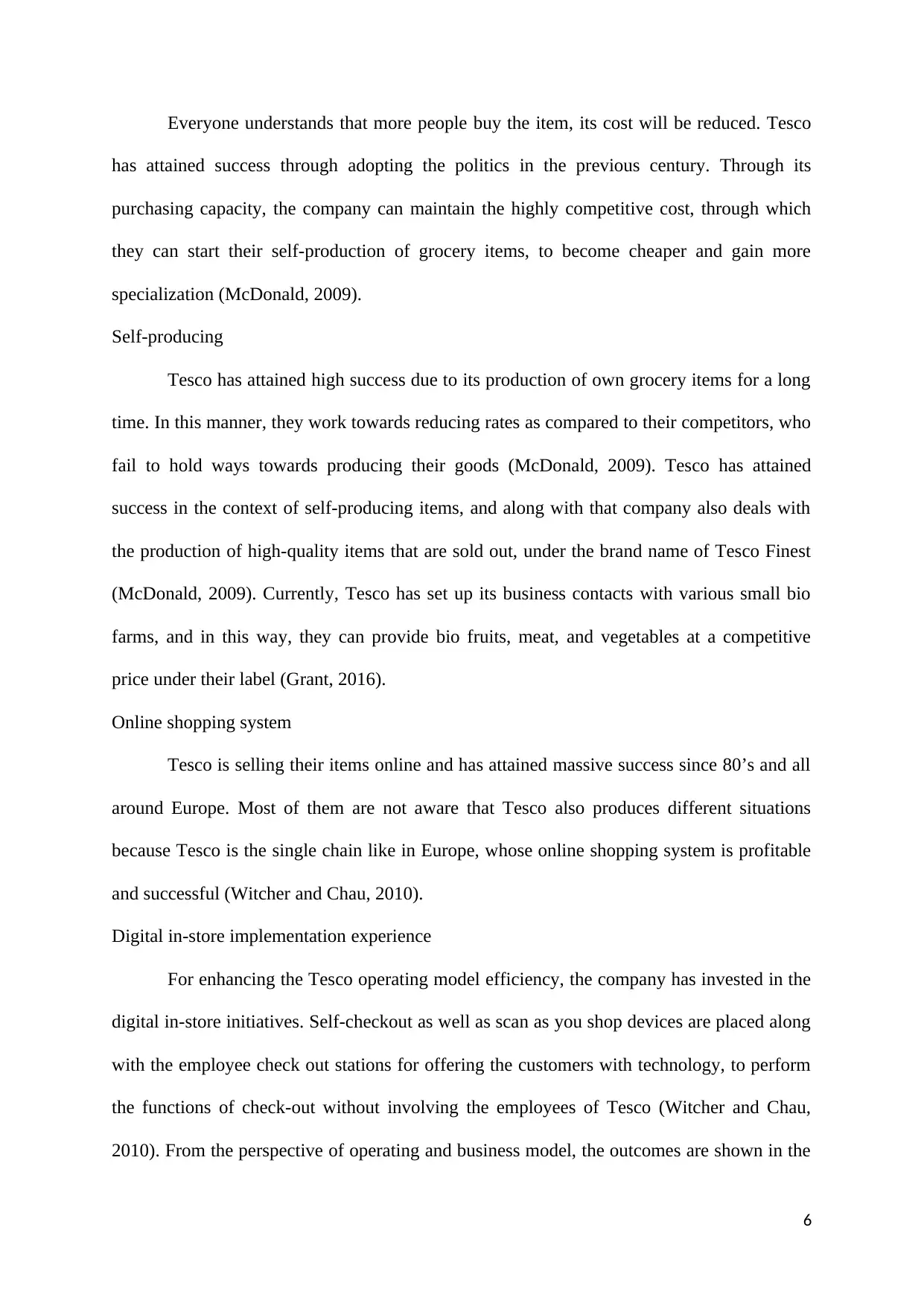
Everyone understands that more people buy the item, its cost will be reduced. Tesco
has attained success through adopting the politics in the previous century. Through its
purchasing capacity, the company can maintain the highly competitive cost, through which
they can start their self-production of grocery items, to become cheaper and gain more
specialization (McDonald, 2009).
Self-producing
Tesco has attained high success due to its production of own grocery items for a long
time. In this manner, they work towards reducing rates as compared to their competitors, who
fail to hold ways towards producing their goods (McDonald, 2009). Tesco has attained
success in the context of self-producing items, and along with that company also deals with
the production of high-quality items that are sold out, under the brand name of Tesco Finest
(McDonald, 2009). Currently, Tesco has set up its business contacts with various small bio
farms, and in this way, they can provide bio fruits, meat, and vegetables at a competitive
price under their label (Grant, 2016).
Online shopping system
Tesco is selling their items online and has attained massive success since 80’s and all
around Europe. Most of them are not aware that Tesco also produces different situations
because Tesco is the single chain like in Europe, whose online shopping system is profitable
and successful (Witcher and Chau, 2010).
Digital in-store implementation experience
For enhancing the Tesco operating model efficiency, the company has invested in the
digital in-store initiatives. Self-checkout as well as scan as you shop devices are placed along
with the employee check out stations for offering the customers with technology, to perform
the functions of check-out without involving the employees of Tesco (Witcher and Chau,
2010). From the perspective of operating and business model, the outcomes are shown in the
6
has attained success through adopting the politics in the previous century. Through its
purchasing capacity, the company can maintain the highly competitive cost, through which
they can start their self-production of grocery items, to become cheaper and gain more
specialization (McDonald, 2009).
Self-producing
Tesco has attained high success due to its production of own grocery items for a long
time. In this manner, they work towards reducing rates as compared to their competitors, who
fail to hold ways towards producing their goods (McDonald, 2009). Tesco has attained
success in the context of self-producing items, and along with that company also deals with
the production of high-quality items that are sold out, under the brand name of Tesco Finest
(McDonald, 2009). Currently, Tesco has set up its business contacts with various small bio
farms, and in this way, they can provide bio fruits, meat, and vegetables at a competitive
price under their label (Grant, 2016).
Online shopping system
Tesco is selling their items online and has attained massive success since 80’s and all
around Europe. Most of them are not aware that Tesco also produces different situations
because Tesco is the single chain like in Europe, whose online shopping system is profitable
and successful (Witcher and Chau, 2010).
Digital in-store implementation experience
For enhancing the Tesco operating model efficiency, the company has invested in the
digital in-store initiatives. Self-checkout as well as scan as you shop devices are placed along
with the employee check out stations for offering the customers with technology, to perform
the functions of check-out without involving the employees of Tesco (Witcher and Chau,
2010). From the perspective of operating and business model, the outcomes are shown in the
6
⊘ This is a preview!⊘
Do you want full access?
Subscribe today to unlock all pages.

Trusted by 1+ million students worldwide

efficient cost savings, because less staff is needed for performing the manual check-out.
Nevertheless, the self-checkout has not come without any issues- the lack of staff supervision
has resulted in the critical fraud level for Tesco (Witcher and Chau, 2010). Tesco is also
trying to merge the thievery by the support of digital receipt technology as well as self-
checkout specialized cameras for passing alertness to the real-time and irregular staff
customer scanning activity (Witcher and Chau, 2010).
Scan as you shop device
Self Service Checkout
7
Nevertheless, the self-checkout has not come without any issues- the lack of staff supervision
has resulted in the critical fraud level for Tesco (Witcher and Chau, 2010). Tesco is also
trying to merge the thievery by the support of digital receipt technology as well as self-
checkout specialized cameras for passing alertness to the real-time and irregular staff
customer scanning activity (Witcher and Chau, 2010).
Scan as you shop device
Self Service Checkout
7
Paraphrase This Document
Need a fresh take? Get an instant paraphrase of this document with our AI Paraphraser

Along with this, video cameras that are in-store, like broccoli cam
try to detect the vegetable as well as fruit tray in the aisles of fresh foods
is depleted by passing the instant messages to the shop floor staff for
taking urgent replenishment. Labels at electronic shelf edge usually
circumvent the requirement for the employees of Tesco to get changed by
5-10 million labels every month, by freeing up the employees valuable
time to emphasize over serving the customers (Witcher and Chau, 2010).
Besides that, labels at electronic shelf edge permits for having the
immediate changes in price all-round the day permits the company to
implement the promotional cost at the noticed moment (Witcher and Chau,
2010). At last, staff are equipped through the portable smart badges, which
while scanning the products offer the team with the stock level
information and further details of the product, permits the staff at shop
floor to answer the queries of customers live (Witcher and Chau, 2010).
Broccoli cam of Tesco
8
try to detect the vegetable as well as fruit tray in the aisles of fresh foods
is depleted by passing the instant messages to the shop floor staff for
taking urgent replenishment. Labels at electronic shelf edge usually
circumvent the requirement for the employees of Tesco to get changed by
5-10 million labels every month, by freeing up the employees valuable
time to emphasize over serving the customers (Witcher and Chau, 2010).
Besides that, labels at electronic shelf edge permits for having the
immediate changes in price all-round the day permits the company to
implement the promotional cost at the noticed moment (Witcher and Chau,
2010). At last, staff are equipped through the portable smart badges, which
while scanning the products offer the team with the stock level
information and further details of the product, permits the staff at shop
floor to answer the queries of customers live (Witcher and Chau, 2010).
Broccoli cam of Tesco
8
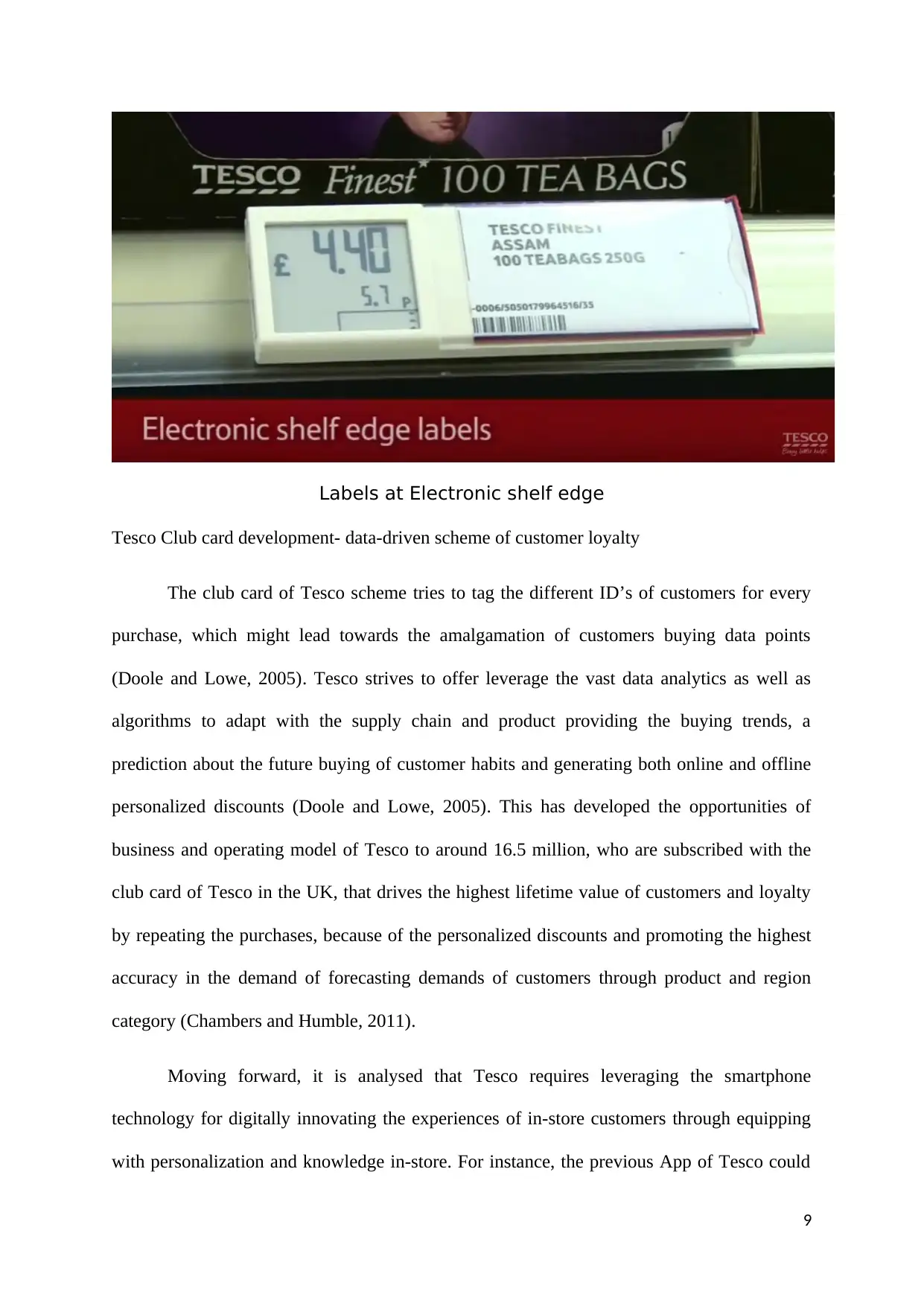
Labels at Electronic shelf edge
Tesco Club card development- data-driven scheme of customer loyalty
The club card of Tesco scheme tries to tag the different ID’s of customers for every
purchase, which might lead towards the amalgamation of customers buying data points
(Doole and Lowe, 2005). Tesco strives to offer leverage the vast data analytics as well as
algorithms to adapt with the supply chain and product providing the buying trends, a
prediction about the future buying of customer habits and generating both online and offline
personalized discounts (Doole and Lowe, 2005). This has developed the opportunities of
business and operating model of Tesco to around 16.5 million, who are subscribed with the
club card of Tesco in the UK, that drives the highest lifetime value of customers and loyalty
by repeating the purchases, because of the personalized discounts and promoting the highest
accuracy in the demand of forecasting demands of customers through product and region
category (Chambers and Humble, 2011).
Moving forward, it is analysed that Tesco requires leveraging the smartphone
technology for digitally innovating the experiences of in-store customers through equipping
with personalization and knowledge in-store. For instance, the previous App of Tesco could
9
Tesco Club card development- data-driven scheme of customer loyalty
The club card of Tesco scheme tries to tag the different ID’s of customers for every
purchase, which might lead towards the amalgamation of customers buying data points
(Doole and Lowe, 2005). Tesco strives to offer leverage the vast data analytics as well as
algorithms to adapt with the supply chain and product providing the buying trends, a
prediction about the future buying of customer habits and generating both online and offline
personalized discounts (Doole and Lowe, 2005). This has developed the opportunities of
business and operating model of Tesco to around 16.5 million, who are subscribed with the
club card of Tesco in the UK, that drives the highest lifetime value of customers and loyalty
by repeating the purchases, because of the personalized discounts and promoting the highest
accuracy in the demand of forecasting demands of customers through product and region
category (Chambers and Humble, 2011).
Moving forward, it is analysed that Tesco requires leveraging the smartphone
technology for digitally innovating the experiences of in-store customers through equipping
with personalization and knowledge in-store. For instance, the previous App of Tesco could
9
⊘ This is a preview!⊘
Do you want full access?
Subscribe today to unlock all pages.

Trusted by 1+ million students worldwide
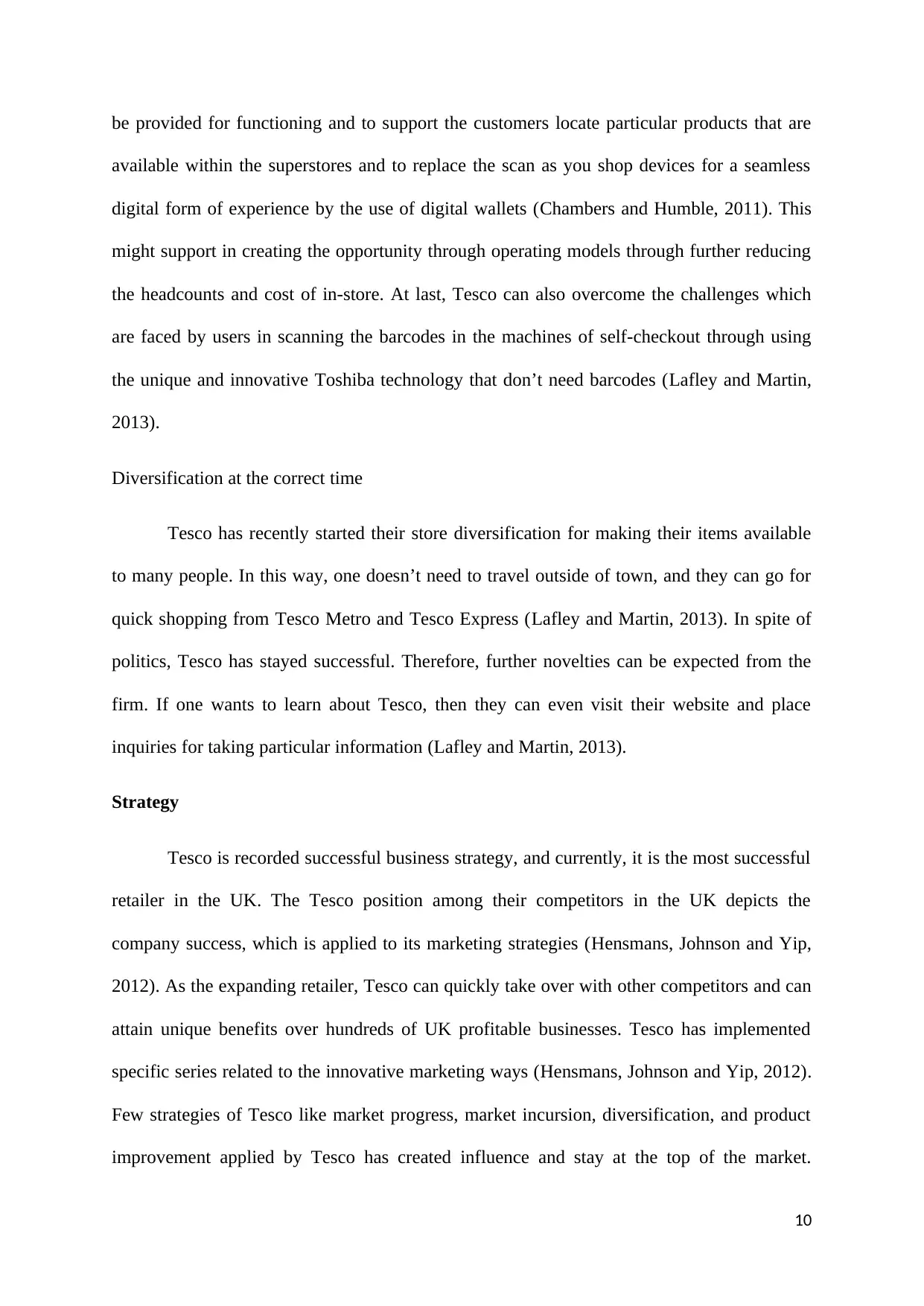
be provided for functioning and to support the customers locate particular products that are
available within the superstores and to replace the scan as you shop devices for a seamless
digital form of experience by the use of digital wallets (Chambers and Humble, 2011). This
might support in creating the opportunity through operating models through further reducing
the headcounts and cost of in-store. At last, Tesco can also overcome the challenges which
are faced by users in scanning the barcodes in the machines of self-checkout through using
the unique and innovative Toshiba technology that don’t need barcodes (Lafley and Martin,
2013).
Diversification at the correct time
Tesco has recently started their store diversification for making their items available
to many people. In this way, one doesn’t need to travel outside of town, and they can go for
quick shopping from Tesco Metro and Tesco Express (Lafley and Martin, 2013). In spite of
politics, Tesco has stayed successful. Therefore, further novelties can be expected from the
firm. If one wants to learn about Tesco, then they can even visit their website and place
inquiries for taking particular information (Lafley and Martin, 2013).
Strategy
Tesco is recorded successful business strategy, and currently, it is the most successful
retailer in the UK. The Tesco position among their competitors in the UK depicts the
company success, which is applied to its marketing strategies (Hensmans, Johnson and Yip,
2012). As the expanding retailer, Tesco can quickly take over with other competitors and can
attain unique benefits over hundreds of UK profitable businesses. Tesco has implemented
specific series related to the innovative marketing ways (Hensmans, Johnson and Yip, 2012).
Few strategies of Tesco like market progress, market incursion, diversification, and product
improvement applied by Tesco has created influence and stay at the top of the market.
10
available within the superstores and to replace the scan as you shop devices for a seamless
digital form of experience by the use of digital wallets (Chambers and Humble, 2011). This
might support in creating the opportunity through operating models through further reducing
the headcounts and cost of in-store. At last, Tesco can also overcome the challenges which
are faced by users in scanning the barcodes in the machines of self-checkout through using
the unique and innovative Toshiba technology that don’t need barcodes (Lafley and Martin,
2013).
Diversification at the correct time
Tesco has recently started their store diversification for making their items available
to many people. In this way, one doesn’t need to travel outside of town, and they can go for
quick shopping from Tesco Metro and Tesco Express (Lafley and Martin, 2013). In spite of
politics, Tesco has stayed successful. Therefore, further novelties can be expected from the
firm. If one wants to learn about Tesco, then they can even visit their website and place
inquiries for taking particular information (Lafley and Martin, 2013).
Strategy
Tesco is recorded successful business strategy, and currently, it is the most successful
retailer in the UK. The Tesco position among their competitors in the UK depicts the
company success, which is applied to its marketing strategies (Hensmans, Johnson and Yip,
2012). As the expanding retailer, Tesco can quickly take over with other competitors and can
attain unique benefits over hundreds of UK profitable businesses. Tesco has implemented
specific series related to the innovative marketing ways (Hensmans, Johnson and Yip, 2012).
Few strategies of Tesco like market progress, market incursion, diversification, and product
improvement applied by Tesco has created influence and stay at the top of the market.
10
Paraphrase This Document
Need a fresh take? Get an instant paraphrase of this document with our AI Paraphraser
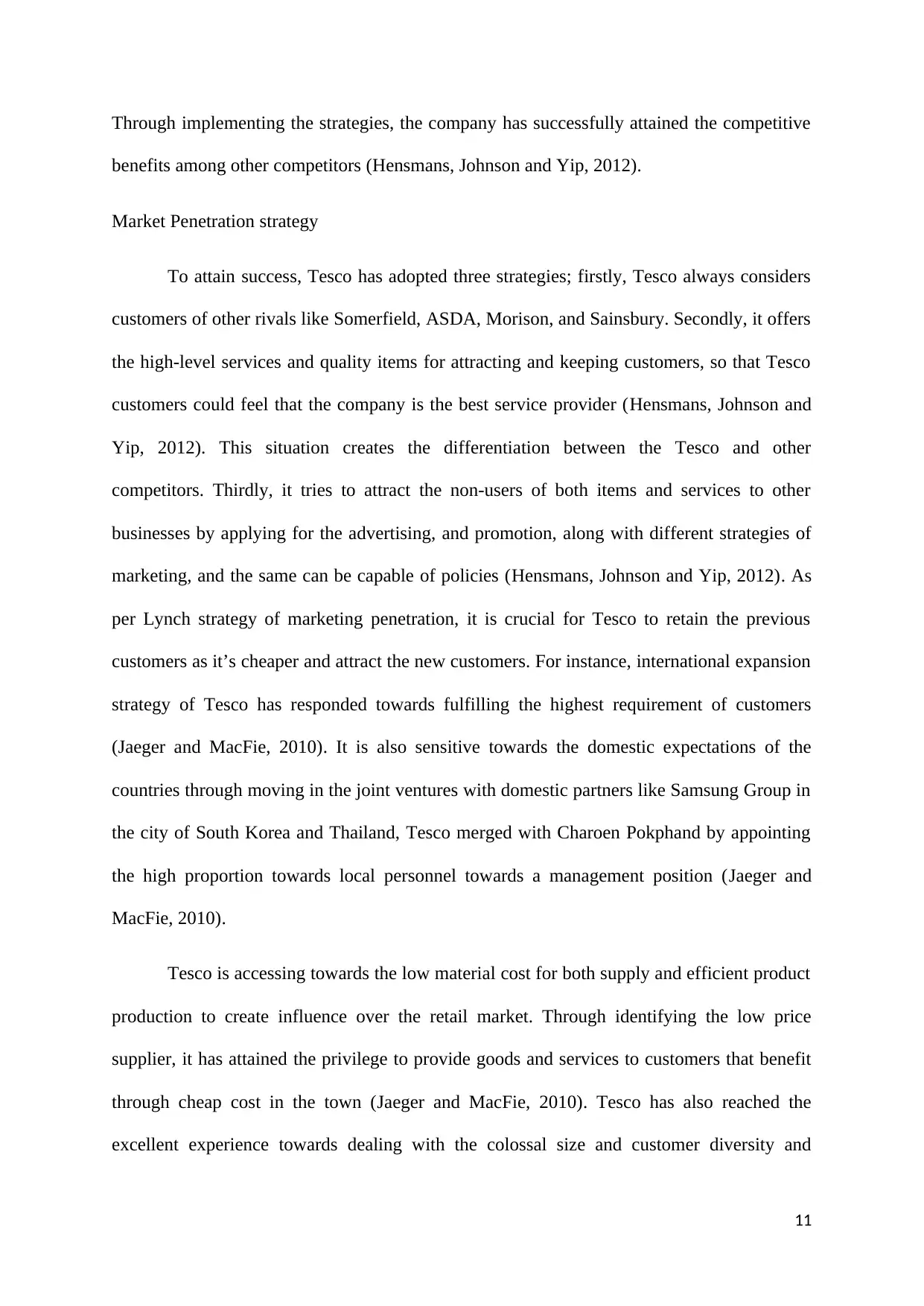
Through implementing the strategies, the company has successfully attained the competitive
benefits among other competitors (Hensmans, Johnson and Yip, 2012).
Market Penetration strategy
To attain success, Tesco has adopted three strategies; firstly, Tesco always considers
customers of other rivals like Somerfield, ASDA, Morison, and Sainsbury. Secondly, it offers
the high-level services and quality items for attracting and keeping customers, so that Tesco
customers could feel that the company is the best service provider (Hensmans, Johnson and
Yip, 2012). This situation creates the differentiation between the Tesco and other
competitors. Thirdly, it tries to attract the non-users of both items and services to other
businesses by applying for the advertising, and promotion, along with different strategies of
marketing, and the same can be capable of policies (Hensmans, Johnson and Yip, 2012). As
per Lynch strategy of marketing penetration, it is crucial for Tesco to retain the previous
customers as it’s cheaper and attract the new customers. For instance, international expansion
strategy of Tesco has responded towards fulfilling the highest requirement of customers
(Jaeger and MacFie, 2010). It is also sensitive towards the domestic expectations of the
countries through moving in the joint ventures with domestic partners like Samsung Group in
the city of South Korea and Thailand, Tesco merged with Charoen Pokphand by appointing
the high proportion towards local personnel towards a management position (Jaeger and
MacFie, 2010).
Tesco is accessing towards the low material cost for both supply and efficient product
production to create influence over the retail market. Through identifying the low price
supplier, it has attained the privilege to provide goods and services to customers that benefit
through cheap cost in the town (Jaeger and MacFie, 2010). Tesco has also reached the
excellent experience towards dealing with the colossal size and customer diversity and
11
benefits among other competitors (Hensmans, Johnson and Yip, 2012).
Market Penetration strategy
To attain success, Tesco has adopted three strategies; firstly, Tesco always considers
customers of other rivals like Somerfield, ASDA, Morison, and Sainsbury. Secondly, it offers
the high-level services and quality items for attracting and keeping customers, so that Tesco
customers could feel that the company is the best service provider (Hensmans, Johnson and
Yip, 2012). This situation creates the differentiation between the Tesco and other
competitors. Thirdly, it tries to attract the non-users of both items and services to other
businesses by applying for the advertising, and promotion, along with different strategies of
marketing, and the same can be capable of policies (Hensmans, Johnson and Yip, 2012). As
per Lynch strategy of marketing penetration, it is crucial for Tesco to retain the previous
customers as it’s cheaper and attract the new customers. For instance, international expansion
strategy of Tesco has responded towards fulfilling the highest requirement of customers
(Jaeger and MacFie, 2010). It is also sensitive towards the domestic expectations of the
countries through moving in the joint ventures with domestic partners like Samsung Group in
the city of South Korea and Thailand, Tesco merged with Charoen Pokphand by appointing
the high proportion towards local personnel towards a management position (Jaeger and
MacFie, 2010).
Tesco is accessing towards the low material cost for both supply and efficient product
production to create influence over the retail market. Through identifying the low price
supplier, it has attained the privilege to provide goods and services to customers that benefit
through cheap cost in the town (Jaeger and MacFie, 2010). Tesco has also reached the
excellent experience towards dealing with the colossal size and customer diversity and
11
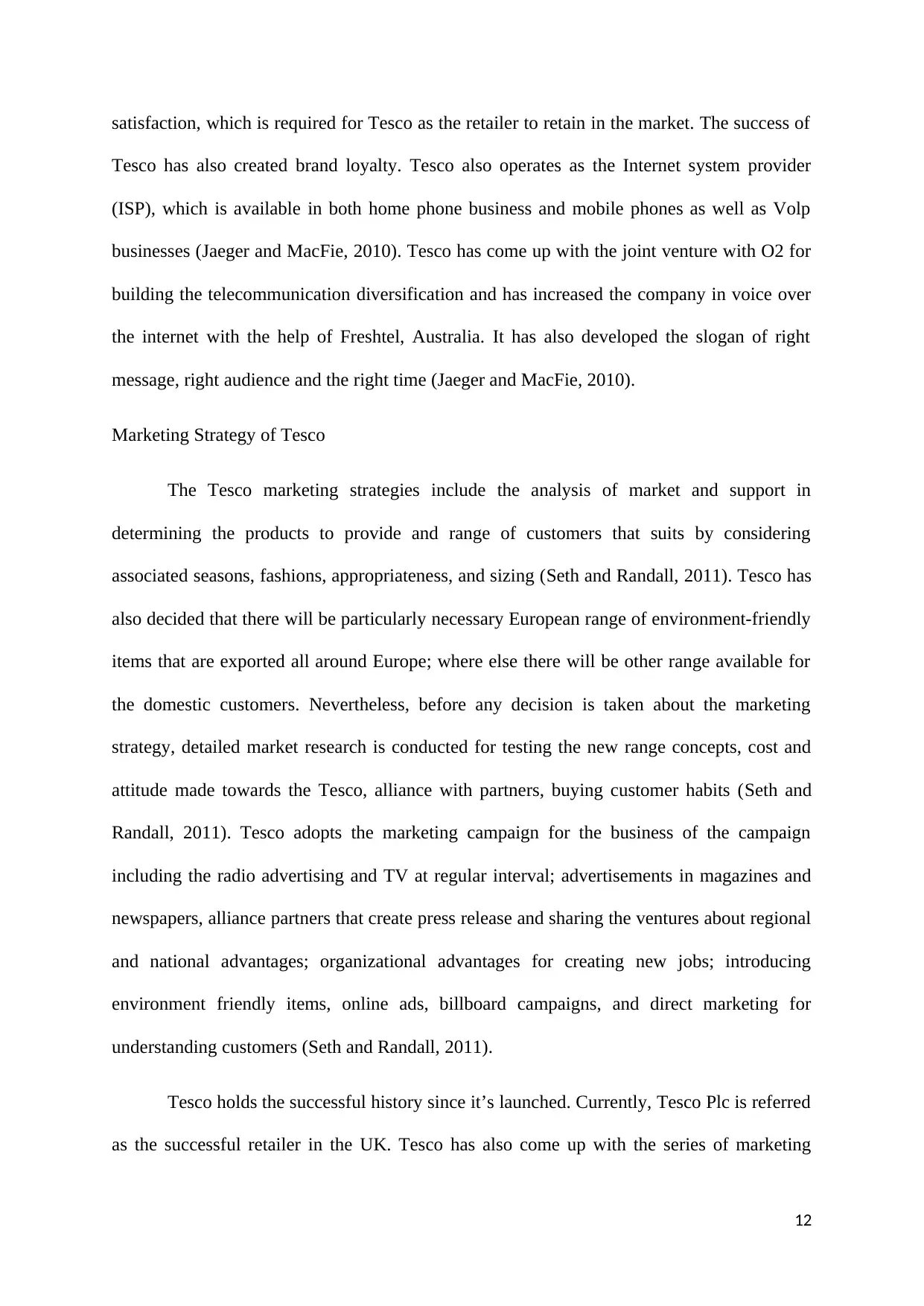
satisfaction, which is required for Tesco as the retailer to retain in the market. The success of
Tesco has also created brand loyalty. Tesco also operates as the Internet system provider
(ISP), which is available in both home phone business and mobile phones as well as Volp
businesses (Jaeger and MacFie, 2010). Tesco has come up with the joint venture with O2 for
building the telecommunication diversification and has increased the company in voice over
the internet with the help of Freshtel, Australia. It has also developed the slogan of right
message, right audience and the right time (Jaeger and MacFie, 2010).
Marketing Strategy of Tesco
The Tesco marketing strategies include the analysis of market and support in
determining the products to provide and range of customers that suits by considering
associated seasons, fashions, appropriateness, and sizing (Seth and Randall, 2011). Tesco has
also decided that there will be particularly necessary European range of environment-friendly
items that are exported all around Europe; where else there will be other range available for
the domestic customers. Nevertheless, before any decision is taken about the marketing
strategy, detailed market research is conducted for testing the new range concepts, cost and
attitude made towards the Tesco, alliance with partners, buying customer habits (Seth and
Randall, 2011). Tesco adopts the marketing campaign for the business of the campaign
including the radio advertising and TV at regular interval; advertisements in magazines and
newspapers, alliance partners that create press release and sharing the ventures about regional
and national advantages; organizational advantages for creating new jobs; introducing
environment friendly items, online ads, billboard campaigns, and direct marketing for
understanding customers (Seth and Randall, 2011).
Tesco holds the successful history since it’s launched. Currently, Tesco Plc is referred
as the successful retailer in the UK. Tesco has also come up with the series of marketing
12
Tesco has also created brand loyalty. Tesco also operates as the Internet system provider
(ISP), which is available in both home phone business and mobile phones as well as Volp
businesses (Jaeger and MacFie, 2010). Tesco has come up with the joint venture with O2 for
building the telecommunication diversification and has increased the company in voice over
the internet with the help of Freshtel, Australia. It has also developed the slogan of right
message, right audience and the right time (Jaeger and MacFie, 2010).
Marketing Strategy of Tesco
The Tesco marketing strategies include the analysis of market and support in
determining the products to provide and range of customers that suits by considering
associated seasons, fashions, appropriateness, and sizing (Seth and Randall, 2011). Tesco has
also decided that there will be particularly necessary European range of environment-friendly
items that are exported all around Europe; where else there will be other range available for
the domestic customers. Nevertheless, before any decision is taken about the marketing
strategy, detailed market research is conducted for testing the new range concepts, cost and
attitude made towards the Tesco, alliance with partners, buying customer habits (Seth and
Randall, 2011). Tesco adopts the marketing campaign for the business of the campaign
including the radio advertising and TV at regular interval; advertisements in magazines and
newspapers, alliance partners that create press release and sharing the ventures about regional
and national advantages; organizational advantages for creating new jobs; introducing
environment friendly items, online ads, billboard campaigns, and direct marketing for
understanding customers (Seth and Randall, 2011).
Tesco holds the successful history since it’s launched. Currently, Tesco Plc is referred
as the successful retailer in the UK. Tesco has also come up with the series of marketing
12
⊘ This is a preview!⊘
Do you want full access?
Subscribe today to unlock all pages.

Trusted by 1+ million students worldwide
1 out of 23
Related Documents
Your All-in-One AI-Powered Toolkit for Academic Success.
+13062052269
info@desklib.com
Available 24*7 on WhatsApp / Email
![[object Object]](/_next/static/media/star-bottom.7253800d.svg)
Unlock your academic potential
Copyright © 2020–2025 A2Z Services. All Rights Reserved. Developed and managed by ZUCOL.





